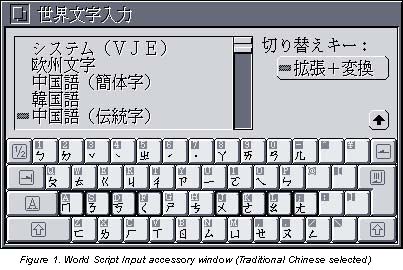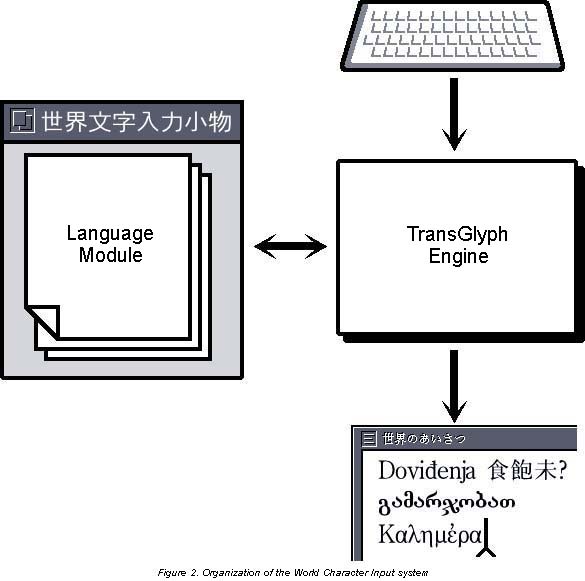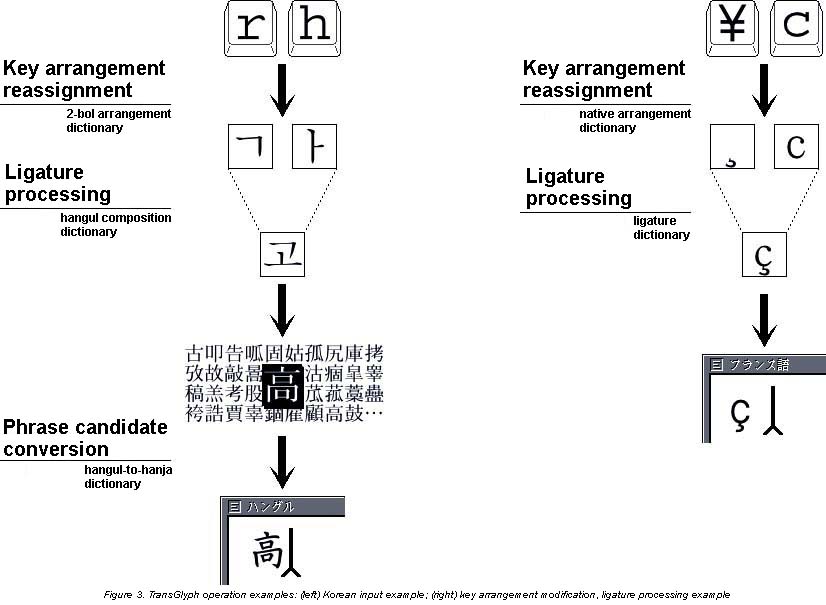

"World Character Input," a new input environment for making the best use of the BTRON multi-character environment has been loaded onto Cho Kanji 2 [B-right/V R2.5]. In this paper, we will explain the merits and give an outline of World Character Input.
World Character Input is a system that enables the user to input from the keyboard all of the characters that can be utilized with Cho Kanji 2. In this system, we arrange and manage key arrangements and conversion algorithms in units called "language modules," which can be employed by switching the exclusive input method for each language.
New language modules are registered merely by dragging the virtual object of the language module to the World Character Input accessory window (Fig. 1). The switching of languages is carried out by simultaneously pushing the Kakuchoo [Alt] and Henkan [Conversion] keys. In addition, in the World Character Input accessory, there is also a function that displays the key layout of the module that has been selected.

A total of 26 language modules have been bundled with Cho Kanji 2 (Table 1).
| Chinese (Simplified) | Norwegian |
| Chinese (Traditional) | Swedish |
| Korean | Finnish |
| Ainu | Hungarian |
| European Input | Polish |
| French A/B | Czechoslovakian |
| German A/B | Slovene |
| Spanish A/B | Turkish |
| Italian A/B | Russian A/B |
| Icelandic | Greek |
| Danish |
The various modules based on the Latin script are made up so that it is possible to input either via the key arrangement based on the typewriter keyboard of each country, or with "diacritical mark back conversion" using the Henkan [Conversion] and Muhenkan [Non-conversion] keys. The latter has enjoyed popularity with the "European Input" [module]. For languages with many students, such as French and German, modules with key arrangements that place maximum consideration on compatibility with the Japanese 106/109-key keyboards have also been prepared. A "Modern Greek" module," which requires an abundance of diacritical marks, and an "Ainu" module, which utilizes characters in JIS level 3, have also been prepared. The hangul-to-hanja [Korean phonetic script to Korean Chinese character] conversion of the Korean module, and the Chuyin-type Taiwan Chinese character conversion of the "Chinese (Traditional)" module also are functions that have heretofore been absent in Cho Kanji.
The World Character Input system is organized as in Fig. 2.

"TransGlyph" is an engine that manages the conversion of characters ("glyph" means a character shape) and conversion operations. Characters input from the keyboard are passed over to the application through the TransGlyph engine after undergoing conversion described in the language module.
Because World Character Input is a function supported at the operating system level, it is possible to input various languages not just into text editor [documents], but also into things such as the names of real objects [files] and the cells of [spreadsheet] tables.
It is possible to both customize the [existing] language modules and create completely new language modules.
Language modules are text real objects formed from key arrangements and dictionaries with collections of candidates for conversion, plus scripts with descriptions of the modules' operations.
With the present script specification, it is possible to modify key arrangements, process ligatures, convert candidate phrases, and process glyph changes in TransGlyph (Fig. 3). Excluding languages with peculiar writing directions, such as Arabic [1], TransGlyph is made up so that it is possible to freely create many language input systems.For details on commands and the like, please refer to "Accessories" in the Cho Kanji 2 manual.

At the TRON Character Resource Center, it is possible to request that characters not included in Cho Kanji 2 be added to TRON Character Code. When requests for characters are combined with World Character Input, an environment will have been prepared in which it becomes possible to input with Cho Kanji even rare languages that seem impermanent. On the other hand, on the point of system-wide multilingual processing, there are many issues remaining even with Cho Kanji. At Personal Media we are planning to put effort into support for the language of each nation even in the future. It is our hope that World Character Input will be used by both individuals and groups of users.
____________________
[1] Because the character direction is fixed in Cho Kanji applications, it was not possible to make a text input module for languages such as Arabic, which are written from right to left.
B-right is a registered trademark of Personal Media Corporation.
The above article on World Character Input appeared on pages 18 and 19 in Vol. 64 of TRONWARE . It was translated and loaded onto this Web page with the permission of Personal Media Corporation.
Copyright © 2000 Personal Media Corporation
Copyright © 2000 Sakamura Laboratory, University Museum, University of Tokyo